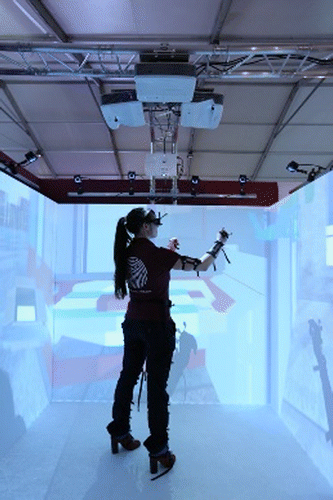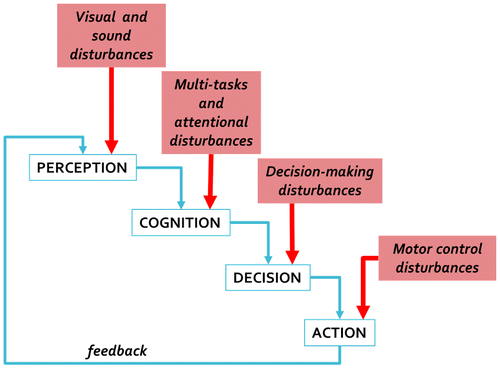1. Introduction
Falls are a major problem in Public Health and are the consequence of multifactorial determinants in the elderly and in patients with Parkinson disease that require a functional and global approach to elaborate preventive strategies (Léon and Beck Citation2014). Most falls occur during movement, with an increasing risk of falling when attentive phenomenon are diverted from the objective of action (Inserm Citation2015). The standardized methods in the clinical setting often focus on evaluation of a specific walking exercise without disturbance in the environment and without challenging balance control. We describe the design of a system using a virtual environment and a human metrology to assess how attention demanding and unexpected events influence a person’s ability to control balance, gait and movement. Industrial partners currently develop this integrated system of immersion and metrology. This is one of the innovative, technological platforms of the ‘Hôpital Virtuel de Lorraine’. The main objective of the project is to define a model that is able 1) to explain raw measurement data in the Closed-Loop ‘Perception – Cognition – Decision - Action’ and 2) to predict an increase in the falling risk (HAS Citation2012).
2. Methods
The platform is designed to 1) produce user experiences that illustrate everyday life in a stable virtual world and 2) provide an assessment-standardized tool for clinicians in order to objectify human behaviors and their consequences. The predictors of further falls are obtained by measures on neuro-psycho-motor responses in order to identify data processing of the closed-loop: perception-cognition-decision-action (Fuchs Citation2006, Citation2009).
The virtual environment can be displayed on a CAVE (Figure ) and a head-mounted display (HMD) with integrated eye tracker in order to analyse the visual exploration patterns and identify attention parameters. The virtual reality experience is improved with a first-person perspective and a virtual avatar synchronized with the real gesture movements of the person (Slater et al. Citation2010). The hardware in the platform integrates a server that computes virtual environment, collect data from many wearable sensors (physiological sensors, kinetics sensors and kinematics sensors) and process data in order to score fall factors.
The structure and the parameters of the predictive model will be defined by a meta-analysis (top-down approach) based on knowledge of the literature and experts of the analysis of the fall. From this study, we design a neuro-psycho-motor immersion and the disturbances in order to collect information from the motor control closed-loop (Figure ). The next step consists in developing an automated workflow in order to process raw data and calculate score parameters of the model. Machine Learning approaches will be used to perform the multivariate analysis (Özdemir and Barshan Citation2014).
3. Results and discussion
The preliminary pilot study will concern 25 subjects (age 65–85) in the elderly with at least two falls in the past twelve months and 25 with no fall, 25 subjects with Parkinson’s disease evaluated with the modified UPDRS III (Goetz et al. Citation2007) in order to validate the assessment-standardized tool. Clinicians will be able to replay user experiences of our patients in order to personalize a physical activity program and in according to the identification of the ‘Perception-Cognition-Decision-Action’ model.
4. Conclusions
Clinicians would like an automated and low cost version of the virtual reality platform. The results of our study will be implemented in this device in order to understand the predictive parameters of fall risks in their own offices. The advantages of this VR solution provides stable settings and optimal control of the environment.
Acknowledgements
The “Hôpital Virtuel de Lorraine” project, funded by the FEDER program.
Industrial partners:
| • | Pharmagest Interactive – Diatelic (5 Allée de St Cloud – 54600 Villers-lès-Nancy) | ||||
| • | HRV-Simulation (21 Rue Ferdinand Buisson, 53810 Changé) | ||||
| • | TEA (3 Rue Bois Chêne le Loup, 54506 Vandœuvre-lès-Nancy) | ||||
References
- Fuchs P. 2006. Le traité de la réalité virtuelle – Volume 4. Paris: Presses de l’Ecole des Mines.
- Fuchs P. 2009. Le traité de la réalité virtuelle – Volume 5. Paris: Presses de l’Ecole des Mines.
- Goetz CG, Fahn S, Martinez-Martin P, Poewe W, Sampaio C, Stebbins GT, Stern MB, Tilley BC, Dodel R, Dubois B, et al. 2007. Movement Disorder Society-sponsored revision of the Unified Parkinson’s Disease Rating Scale (MDS-UPDRS): Process, format, and clinimetric testing plan. Mov Disord. 22:41–47.10.1002/(ISSN)1531-8257
- HAS. 2012. Référentiel concernant l’évaluation du risque de chutes chez le sujet âgé autonome et sa prévention.
- INSERM Institut national de la santé et de la recherche médicale. 2015. Activité physique et prévention des chutes chez les personnes âgées. Paris: Inserm.
- Léon C, Beck F. 2014. Les comportements de santé des 55-85 ans analyses du Baromètre santé 2010. Saint-Denis: Inpes éd.
- Özdemir A, Barshan B. 2014. Detecting falls with wearable sensors using machine learning techniques. Sensors. 14:10691–10708.10.3390/s140610691
- Slater M, Spanlang B, Sanchez-Vives MV, Blanke O. 2010. First person experience of body transfer in virtual reality. Williams MA, editor. PLoS ONE. 5: e10564.


